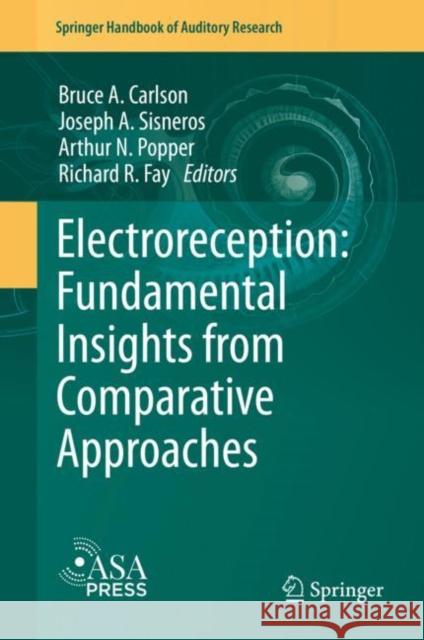Electroreception: Fundamental Insights from Comparative Approaches » książka



Electroreception: Fundamental Insights from Comparative Approaches
ISBN-13: 9783030291044 / Angielski / Twarda / 2019 / 367 str.
Electroreception: Fundamental Insights from Comparative Approaches
ISBN-13: 9783030291044 / Angielski / Twarda / 2019 / 367 str.
(netto: 653,27 VAT: 5%)
Najniższa cena z 30 dni: 655,41 zł
ok. 22 dni roboczych
Bez gwarancji dostawy przed świętami
Darmowa dostawa!
1. The Evolution of Electroreception: An Historical Overview
Bruce A. Carlson and Joseph A. Sisneros
This chapter will provide an historical introduction to the field that focuses on evolutionary diversity. This will include a description of phylogenetic diversity that helps orient readers to the various taxonomic groups that have electroreception. It will also address phenotypic diversity, including differences between tuberous and ampullary electrosensory systems, and the wide variety of tuberous electrosensory systems, and how these differences are adapted to behavioral function.
2. Comparative Genomics Approaches to the Evolution and Development of Electroreceptors
Clare V. Baker
3. Comparative Genomics Approaches to the Evolution and Development of Electric Organs
Graciela A. Unguez, Jason R. Gallant, and Harold H. Zakon
4. Biophysical Basis of Electric Signal Diversity
Michael R. Markham
5. Evolutionary Drivers of Electric Signal Diversity
Rüdiger Krahe
This chapter will focus on ecological genetics and the ultimate evolutionary causes of EOD diversification in gymnotiforms and mormyroids, including ecological adaptation, sexual selection, and predation. In addition, this chapter will address the role of electric signaling in species diversification.
6. Sensory Adaptations to Active Sensing and Communication
Eric S. Fortune
7. Evolution of Time-Coding in Electrosensory and Auditory Systems
Bruce A. Carlson
8. Envelope Coding and Processing
Maurice J. Chacron
9. Spatial Learning and the Telencephalon
Leonard Maler
There have been exciting advances in understanding the neural bases of spatial learning and navigation in recent years, but much of this work is limited in its taxonomic scope. The focus of this chapter will be on recent advances in our understanding of spatial learning in gymnotiform fishes and its neural basis in the telencephalon. There will be a particular emphasis on how the electrosensory system of fishes can be used to identify fundamental aspects of spatial learning and its neural basis across vertebrates.
10. Sensorimotor Integration in the Processing of Reafferent Sensory Input
Nathaniel B. Sawtell
Decades of research on mormyrid electric fishes have provided tremendous insights into sensorimotor integration, filtering of reafferent and exafferent sensory input, and the generation and subtraction of sensory expectations. This chapter will focus on the most recent developments in this field, which have revealed the cellular, synaptic, and circuit bases for generating and subtracting sensory expectations, using a combination of computational and experimental studies. There will be a particular emphasis on links to auditory processing and behavior in mammals, and how research on these fishes has led to fundamental insights into the processing of reafferent sensory input.
11. Hormonal Influences on Social Behavior
Ana Silva
This chapter will address hormonal influences on social behavior through actions on sensory and motor systems. There will be a particular focus on diversity in social behavior, and how hormonal actions differ in species with divergent aggressive behavior.
12. Predatory Behavior of Strongly Electric Fish
Kenneth C. Catania
Bruce A. Carlson is Professor of Biology at Washington University in St. Louis.
Joseph A. Sisneros is Professor of Psychology at the University of Washington, Seattle
Arthur N. Popper is Professor Emeritus and research professor in the Department of Biology at the University of Maryland, College Park
Richard R. Fay is Distinguished Research Professor of Psychology at Loyola
This book provides a comparative perspective on the topic of electroreception and reviews some of the fundamental insights gained from studies of electrosensory and electromotor systems to understand how the nervous system extracts biologically relevant information from the natural environment
A Brief History of Electrogenesis and Electroreception in Fishes
Bruce A. Carlson and Joseph A. Sisneros
The Development and Evolution of Lateral Line Electroreceptors: Insights from Comparative Molecular Approaches
Clare V. H. Baker
Electrosensory Transduction: Comparisons Across Structure, Afferent Response Properties, and Cellular Physiology
Duncan B. Leitch and David Julius
The Evolution and Development of Electric Organs
Jason R. Gallant
Biophysical Basis of Electric Signal Diversity
Michael R. Markham
Hormonal Influences on Social Behavior in South American Weakly Electric Fishes
Ana C. Silva
Evolutionary Drivers of Electric Signal Diversity
Rüdiger Krahe
Using Control Theory to Characterize Active Sensing in Weakly Electric Fishes
Sarah A. Stamper, Manu S. Madhav, Noah J. Cowan, and Eric S. Fortune
Envelope Coding and Processing: Implications for Perception and Behavior
Michael G. Metzen and Maurice J. Chacron
Evolution of Submillisecond Temporal Coding in Vertebrate Electrosensory and Auditory Systems
Bruce A. Carlson
Influences of Motor Systems on Electrosensory Processing
Krista Perks and Nathaniel B. Sawtell
Active Electrolocation and Spatial Learning
Sarah Nicola Jung and Jacob Engelmann
Bruce A. Carlson is Professor of Biology at Washington University in St. Louis
Joseph A. Sisneros is Professor of Psychology at the University of Washington, Seattle
Arthur N. Popper is Professor Emeritus and research professor in the Department of Biology at the University of Maryland, College Park
1997-2025 DolnySlask.com Agencja Internetowa
KrainaKsiazek.PL - Księgarnia Internetowa









